Insulin/IGF-1 signaling, including class II/III PI3Ks, β-arrestin and SGK-1, is required in C. elegans to maintain pharyngeal muscle performance during starvation
- PMID: 23700438
- PMCID: PMC3659082
- DOI: 10.1371/journal.pone.0063851
Insulin/IGF-1 signaling, including class II/III PI3Ks, β-arrestin and SGK-1, is required in C. elegans to maintain pharyngeal muscle performance during starvation
Abstract
In C. elegans, pharyngeal pumping is regulated by the presence of bacteria. In response to food deprivation, the pumping rate rapidly declines by about 50-60%, but then recovers gradually to baseline levels on food after 24 hr. We used this system to study the role of insulin/IGF-1 signaling (IIS) in the recovery of pharyngeal pumping during starvation. Mutant strains with reduced function in the insulin/IGF-1 receptor, DAF-2, various insulins (INS-1 and INS-18), and molecules that regulate insulin release (UNC-64 and NCA-1; NCA-2) failed to recover normal pumping rates after food deprivation. Similarly, reduction or loss of function in downstream signaling molecules (e.g., ARR-1, AKT-1, and SGK-1) and effectors (e.g., CCA-1 and UNC-68) impaired pumping recovery. Pharmacological studies with kinase and metabolic inhibitors implicated class II/III phosphatidylinositol 3-kinases (PI3Ks) and glucose metabolism in the recovery response. Interestingly, both over- and under-activity in IIS was associated with poorer recovery kinetics. Taken together, the data suggest that optimum levels of IIS are required to maintain high levels of pharyngeal pumping during starvation. This work may ultimately provide insights into the connections between IIS, nutritional status and sarcopenia, a hallmark feature of aging in muscle.
Conflict of interest statement
Figures







Similar articles
-
SHC-1/p52Shc targets the insulin/IGF-1 and JNK signaling pathways to modulate life span and stress response in C. elegans.Genes Dev. 2008 Oct 1;22(19):2721-35. doi: 10.1101/gad.478408. Genes Dev. 2008. PMID: 18832074 Free PMC article.
-
Aging-dependent and -independent modulation of associative learning behavior by insulin/insulin-like growth factor-1 signal in Caenorhabditis elegans.J Neurosci. 2005 Nov 23;25(47):10894-904. doi: 10.1523/JNEUROSCI.3600-04.2005. J Neurosci. 2005. PMID: 16306402 Free PMC article.
-
Mutation of daf-2 extends lifespan via tissue-specific effectors that suppress distinct life-limiting pathologies.Aging Cell. 2021 Mar;20(3):e13324. doi: 10.1111/acel.13324. Epub 2021 Feb 20. Aging Cell. 2021. PMID: 33609424 Free PMC article.
-
Insulin/insulin-like growth factor signaling in C. elegans.WormBook. 2013 Dec 26:1-43. doi: 10.1895/wormbook.1.164.1. WormBook. 2013. PMID: 24395814 Free PMC article. Review.
-
Insulin and Memory in Invertebrates.Front Behav Neurosci. 2022 Apr 26;16:882932. doi: 10.3389/fnbeh.2022.882932. eCollection 2022. Front Behav Neurosci. 2022. PMID: 35558436 Free PMC article. Review.
Cited by
-
Starvation Responses Throughout the Caenorhabditiselegans Life Cycle.Genetics. 2020 Dec;216(4):837-878. doi: 10.1534/genetics.120.303565. Genetics. 2020. PMID: 33268389 Free PMC article. Review.
-
Context-dependent regulation of feeding behaviour by the insulin receptor, DAF-2, in Caenorhabditis elegans.Invert Neurosci. 2016 Jun;16(2):4. doi: 10.1007/s10158-016-0187-2. Epub 2016 May 21. Invert Neurosci. 2016. PMID: 27209024 Free PMC article.
-
Modulation of CT1 Function: From Klotho Protein to Ammonia and Beyond.Front Nutr. 2021 May 10;8:660021. doi: 10.3389/fnut.2021.660021. eCollection 2021. Front Nutr. 2021. PMID: 34041260 Free PMC article. No abstract available.
-
Energy Scarcity Promotes a Brain-wide Sleep State Modulated by Insulin Signaling in C. elegans.Cell Rep. 2018 Jan 23;22(4):953-966. doi: 10.1016/j.celrep.2017.12.091. Epub 2018 Jan 28. Cell Rep. 2018. PMID: 29386137 Free PMC article.
-
Neuropeptides and Behaviors: How Small Peptides Regulate Nervous System Function and Behavioral Outputs.Front Mol Neurosci. 2021 Dec 2;14:786471. doi: 10.3389/fnmol.2021.786471. eCollection 2021. Front Mol Neurosci. 2021. PMID: 34924955 Free PMC article. Review.
References
-
- Lawlor MA, Alessi DR (2001) PKB/Akt: a key mediator of cell proliferation, survival and insulin responses? J Cell Sci 114: 2903–2910. - PubMed
-
- Bhaskar PT, Hay N (2007) The two TORCs and Akt. Dev Cell 12: 487–502. - PubMed
-
- Kenyon C, Chang J, Gensch E, Rudner A, Tabtiang R (1993) A C. elegans mutant that lives twice as long as wild type. Nature 366: 461–464. - PubMed
-
- Tatar M, Kopelman A, Epstein D, Tu MP, Yin CM, et al. (2001) A mutant Drosophila insulin receptor homolog that extends life-span and impairs neuroendocrine function. Science 292: 107–110. - PubMed
MeSH terms
Substances
Grants and funding
LinkOut - more resources
Full Text Sources
Other Literature Sources
Medical
Research Materials
Miscellaneous

